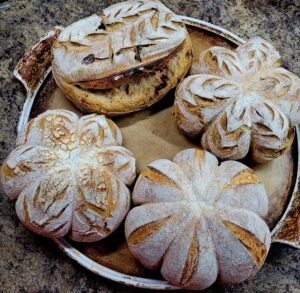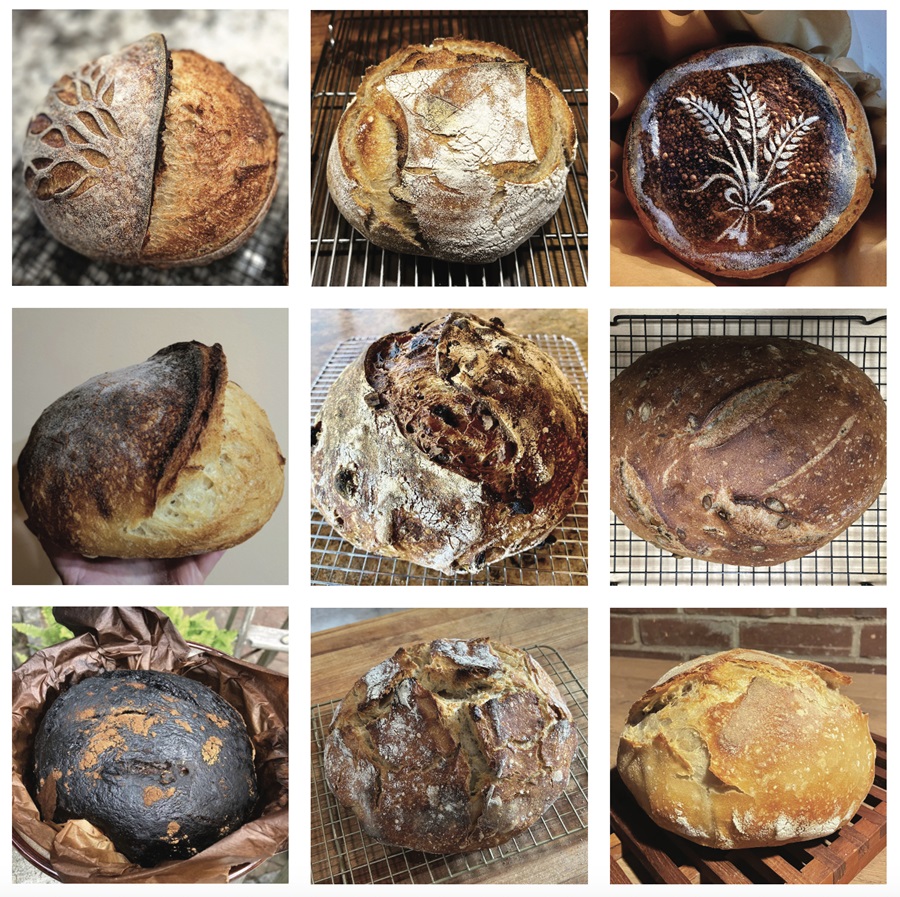Making sourdough bread requires a commitment of time. If you can get hold of a friend’s mature starter and get your loaf underway now, you’ll be taking it out of the oven some 36-plus hours later.
But during that time, you don’t actually have to do much to turn a blob of starter into a crusty loaf. You just need to nudge things along at a few relaxed intervals.
The way sourdough steered my days seemed important when I first started baking. Yes, I was among that pandemic-era throng that took to making sourdough bread to lend precision to days that otherwise dripped by like honey. Back then, I set alarms to be sure I was properly meeting my sourdough’s needs. Now I’m more relaxed.
In my early bread-baking days, I was determined to grow my own starter from scratch — a task that involves a lot of waiting around while an innocuous flour-and-water combo becomes gradually tangier and finally bubbles and ferments.

What was happening was decidedly more scientific than delicious: bacteria in the atmosphere and in the flour began feeding off sugars in the flour. Yeasts and lactic acid bodies began to form — the same culture that exists in yogurt. Those would theoretically produce enough carbon dioxide to leaven a loaf of bread.
What should have resulted was “a vibrant herd of microbes,” according to Bob Holmes in Scientific American. If most breads “rely on a single species of baker’s yeast — the microbial equivalent of a cattle ranch — sourdough is more like the Serengeti, a diverse ecosystem of interacting yeasts and bacteria,” writes Holmes.
My first starter languished, I’ll admit. I didn’t feed it properly. Since then, I’ve learned most people adopt a mature starter. Starters with a past are something bakers brag about.
Then all you have to do is use it and keep it going.
Tending the starter means discarding some of the mixture and then feeding it with equal parts flour and water, giving the bacterial cultures new sugars to feed on. Starters need to be fed once a day if they live outside the fridge but can survive upwards of a week or two if chilled.
In this way, starters take on an ambiguous identity; they are something between project and pet. Paul Greenspan, who lives in Wellfleet, told me about his “kind of immortal” starter named Josh. Josh was originally the spawn of Trudy Vermehren’s starter, also named Josh, after baker-blogger Joshua Weissman.
“People loved the Fox and Crow,” Greenspan says of Vermehren’s now-closed Wellfleet restaurant. Through Josh, he figures, some part of it, maybe the part that used to go into those homemade English muffins, lives on.
Greenspan’s attachment to his starter “has taken some getting used to” among family members, he says. Sometimes, rather than discarding some of Josh when he feeds it, Greenspan starts new Joshes. Greenspan likes to stud his loaves with pecans and dried local cranberries.
Lori Lieberman, who lives in Eastham and Sharon, has a starter that came initially from Seven Stars Bakery in Providence eight years ago. But she has since incorporated dabs of starter from two bakeries she visited in Europe.
Lieberman is a member of “Sourdough Geeks,” an international online community of 537,000 people. She connected with her sourdough-coveting across-the-street neighbor in Eastham in that cybersphere and traded a portion of her starter for a candy apple.
Natalie Shortsleeve, who grew up in Eastham but now lives in South Yarmouth, says that when it comes to bread, she eats only sourdough because of the additives and fillers that clog up other breads. Until a couple of months ago, when she started baking her own, Shortsleeve was driving well over an hour to Maison Villatte in Falmouth for loaves.
When Shortsleeve met someone at a wellness expo who offered her some starter, “it felt like fate,” she says. In the past few months of yeasty experimentation, Shortsleeve’s best loaf was a product of unusual circumstances: she was in a rush and needed her loaf to proof in an hour instead of the usual 24 or so. She let it rise in her bathroom, where, thanks to a space heater, the result was “the most perfect loaf I’ve ever had,” says Shortsleeve. She was told that her starter, originally from Colorado, is at least 15 years old.
That’s an impressive pedigree, but it doesn’t have the seniority of the one Sue Areson, select board vice chair and resident sourdough connoisseur of Truro, has had since she was 14. Areson, now 68, was given a jar of starter by a family she babysat for in Montclair, N.J. She says the starter was about 10 years old when she got it, putting it close now to retirement age.
Since the early ’70s, the starter has been lovingly jockeyed among members of Areson’s family. Her mother took care of it when Areson went to college. These days, Areson says she feels “tethered, maybe,” more than attached to the starter. She likes baking baguettes — especially “the part of it that’s tactile, the kneading of the bread.”A couple of times, her sister-in-law’s dog has stolen her oven-fresh loaf.
Svetlana Gemborys of Brewster also has a nostalgic connection to her dough. Growing up in Blagovgrad, Bulgaria, Gemborys would travel to a village outside the city to visit her grandmother, a sourdough aficionado. There, “everything was homegrown and handcrafted,” she says.
Gemborys’s memories of her grandmother are vivid: “She used to dehydrate her sourdough starter, and it looked like little clay balls,” she says. Gemborys began baking in 2022 — a shockingly short time given her flawless loaves — with a 10-page sourdough recipe from Bulgaria.

Then there’s Mark Bensky of Truro, who never thought he’d be a sourdough fanatic. “It’s a huge commitment to keep this thing alive,” he says, “but I got the bug.” Since he started baking during the early part of the pandemic, Bensky has amassed a small Dutch oven collection and developed an affinity for ancient grain flours like einkorn and spelt. He shies away from white flour and always adds a little rye.
When Ann Phelan of Dennis gets home from a trip, she makes a beeline for her fridge to check on her starter. “Every bread I make is like a Christmas present; I never know what it’ll be like,” she says.
Phelan admits to some mistakes. She once forgot about two sourdough loaves and let them bake for six hours. When she pulled them out of the oven, “they looked like prehistoric rocks,” she says. “They could’ve been a weapon in the Viking days.” Phelan threw them in her back yard, where she thought wildlife might enjoy them. They stayed there for months, untouched.
And what about my failed starter? I got starter-ed again recently, thanks to Peter Warnock of Provincetown, who instructed me as I left his house not to cover it too tightly: “it needs to breathe!” he said.
Warnock now estimates he’s given 12 Cape Codders some of his starter. His words of wisdom are to share your starter and steer clear of other wisdom — sourdough lore frequently contradicts itself and interferes with bakers’ confidence in their own observations.
If there’s one thing to be gleaned from the Cape’s sourdough culture, it’s that, though starters can be temperamental, there’s no shortage of ways to make a perfect loaf.
The recipe that’s worked best for me so far comes from Alexandra’s Kitchen, which notes the timing for your loaf will depend on the strength of your starter and the temperature and humidity of your kitchen. Visual cues are better than rulebook ones, when it comes to sourdough loaves.
You’re going to need a couple of essentials to make this bread. You’ll notice that my recipe is in grams. If you really want to make a good loaf, you are going to need to weigh your ingredients. Once you have a good kitchen scale, you’ll be amazed how often you use it. You also need a Dutch oven — that is, a heavy pot with a tight-fitting lid. This creates a kind of steam oven within your oven. It makes a huge difference in getting your loaf nice and airy.
In spite of the recipe calling for starting with a 550° F oven, I bake mine in an oven that will only reach 500° F — proof enough that even though the sourdough-making process seems exacting, it’s still somewhat flexible.
ONE PERFECT SOURDOUGH LOAF
100 g. active, bubbly sourdough starter (fed within previous 12 hours)
500 g. bread flour
12 g. sea salt
375 g. water
Flour for dusting (can be all-purpose or bread flour)
1. In a large bowl, combine your active starter and water, stirring them together with a fork. In a separate medium bowl, mix your flour and salt. Pour flour mixture into your wet ingredients and stir with your hands until a shaggy dough forms. Make sure there are no dry floury pockets. Cover the bowl with a damp dish towel for 30 minutes.
2. After 30 minutes are up, do a series of five “stretch-and-folds,” pulling the dough up and folding it over itself in the bowl. (If you’ve never done this before, I recommend watching the tutorial on Alexandra’s Kitchen. Those 24 seconds might make or break your loaf.) Repeat every 30 minutes over a two-hour period.
3. Cover the dough with a towel and let it rest at room temperature for 10 to 12 hours (overnight works well). If your house is warm, it may need less time. You’ll know it’s ready when the dough has roughly doubled in size and is supple and a bit jiggly when you move the bowl.
4. Turn the dough out onto a floured surface and shape the dough. (There are online tutorials for this, too!) Fold the dough like an envelope (two thirds of it down toward the center, the other third up to overlap with it) four times, then give the loaf a quarter turn and repeat. Create surface tension by pulling gently downward on the outside of the loaf and creating a seam underneath.
5. Rub flour into a dish towel to prevent sticking and line a bowl with it. Turn your dough back into the bowl, seam side up. Cover and put in the fridge for 24 hours.
6. When ready to bake, put your Dutch oven into the oven and preheat to 550° F. Turn your dough out onto a piece of parchment paper. Score it by making one or two long cuts into its surface.
7. Once oven is hot, lower your dough into the Dutch oven, cover it, and lower oven temperature to 450° F. Bake for 30 minutes.
8. After 30 minutes, remove the lid, lower the oven temperature to 400°F and bake for 15 minutes more.



